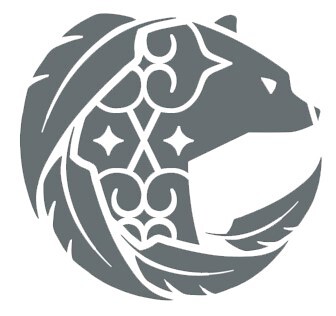The Takeaway
A new Air Self-Defense Force (ASDF) 2nd Air Wing logo, which appears to use Indigenous Ainu traditional patterns, has reinvigorated debates about reconciliation, cultural appropriation, and the protection of traditional Indigenous knowledge in Japan.
In Brief
On December 1, 2022, the ASDF 2nd Air Wing in Chitose city, Hokkaido Prefecture, unveiled a new logo for use on the aircraft wings of the 201st and 203rd squadrons. According to their official Twitter page, the logo consists of a bear with two feathers on the back representing the 2nd Air Wing, and an additional two feathers on the bottom representing the two squadrons. While planes featuring this logo began operations in December, it has received considerable backlash for its alleged “appropriation” of traditional Ainu patterns.
On January 16, the Citizens’ Alliance for the Examination of Ainu Policy, a group established by Ainu individuals and non-Ainu researchers based in Sapporo, formally sent a petition to Prime Minister Kishida Fumio, the Cabinet Secretariat's Comprehensive Ainu Policy Office director, and the ASDF 2nd Air Wing Commander, requesting that the ASDF stop using the logo. The Citizens’ Alliance argues that the logo, which incorporates Ainu patterns, falls under Ainu “traditional knowledge” and its use without prior and substantive consent of the broader Ainu community “is contrary to the spirit of the UN Declaration of the Rights of Indigenous peoples (UNDRIP),” which Japan signed in 2007.
In response, the Air Wing states that “the designer merely used their impression and respect for Ainu culture as an inspiration for the new design.” The ASDF further states that they made inquiries to related organizations such as the Ainu Association of Hokkaido and the patent office and confirmed that there were no issues in using the logo design.
Implications
The ASDF Chitose base has long used a bear and salmon as mascots in their public relations materials, but according to researchers, several components of the new logo overlap with “basic patterns of Ainu culture.” In addition to the use of a bear, which is one of the most sacred beings, or kamuy, in Ainu culture, there are three traditional Ainu patterns easily recognizable in the logo.
Morew, made up of the words slow/quiet and curve, is a symbol representing strength and power; ayusi, which represents thorns, offers protection against the intrusion of evil spirits; and sik, which looks like a star, is meant “to gently watch over you like the stars in the sky.”

According to the ASDF public relations office, the Chitose Ainu Association had “no particular opinion” on the design. And since intellectual property of Ainu peoples’ traditional knowledge is not protected under national law, the Ainu Association of Hokkaido could only tell the ASDF that “the association does not have the authority to authorize the use of Ainu patterns,” and convey that misunderstanding may occur if Ainu patterns were used without careful explanation.
International agreements such as UNDRIP explicitly state that Indigenous Peoples have rights to their own traditional knowledge, and Indigenous traditional knowledge (ITK) and related intellectual property rights are discussed in other international-level treaties and bodies, such as the Convention on Biological Diversity and the World Intellectual Property Organization. Nonetheless, Ainu traditional knowledge was not dealt with in the 2019 Ainu Policy Promotion Act (APPA), the first law in Japan to recognize Ainu as Indigenous Peoples.
As in Indigenous communities across the world, there are numerous views and perspectives among Ainu people. Moreover, Ainu are in the process of historical reconciliation with the state and wider Japanese society, re-emerging as a proud people after having experienced generational trauma due to colonial legacies and discrimination. This can make the process of dealing with traditional knowledge and free and prior informed consent (FPIC) challenging, even for what may appear as simple as creating a logo. As the appeal highlights, many Ainu oppose the idea of ASDF Chitose using a logo with Ainu designs on military aircraft. Gaining FPIC from the broader Ainu community, though difficult, is a necessary step towards Indigenous reconciliation in Japan; there are guiding documents and international precedents that can help provide potential solutions.
What's Next
1. Revision of the 2019 APPA
According to the law’s supplementary provisions, the law can be reviewed and revised in 2024. Many Ainu and non-Ainu citizen organizations have been working to further include Ainu voices and expand and develop the law to bring it closer in line with UNDRIP, including protection of intellectual property rights for traditional Ainu expressions, patterns, and culture.
2. Advancing reconciliation and awareness of Indigenous issues in Japan
The APPA requires national and local governments to support the promotion of the public’s understanding of Ainu culture through education, tourism, and other activities, but the continuing proliferation of hate speech, discrimination, and a general lack of societal awareness of these issues are signs that more can be done.
3. International pressure
A month before Japan hosted the G8 Summit in Hokkaido in 2008, the Japanese Diet unanimously granted Ainu recognition as Indigenous Peoples. With Japan set to host the G7 in Hiroshima in May 2023, many observers will be watching to see if the government takes steps to further advance Ainu recognition, rights, and reconciliation.
• Produced by CAST’s Northeast Asia team: Dr. Scott Harrison (Senior Program Manager); Momo Sakudo (Analyst); and Tae Yeon Eom (Analyst).




